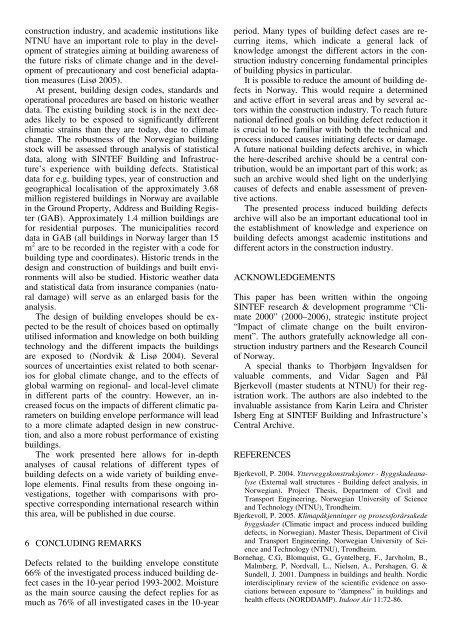Lisø PhD Dissertation Manuscript - NTNU
Lisø PhD Dissertation Manuscript - NTNU
Lisø PhD Dissertation Manuscript - NTNU
You also want an ePaper? Increase the reach of your titles
YUMPU automatically turns print PDFs into web optimized ePapers that Google loves.
construction industry, and academic institutions like<br />
<strong>NTNU</strong> have an important role to play in the development<br />
of strategies aiming at building awareness of<br />
the future risks of climate change and in the development<br />
of precautionary and cost beneficial adaptation<br />
measures (<strong>Lisø</strong> 2005).<br />
At present, building design codes, standards and<br />
operational procedures are based on historic weather<br />
data. The existing building stock is in the next decades<br />
likely to be exposed to significantly different<br />
climatic strains than they are today, due to climate<br />
change. The robustness of the Norwegian building<br />
stock will be assessed through analysis of statistical<br />
data, along with SINTEF Building and Infrastructure’s<br />
experience with building defects. Statistical<br />
data for e.g. building types, year of construction and<br />
geographical localisation of the approximately 3.68<br />
million registered buildings in Norway are available<br />
in the Ground Property, Address and Building Register<br />
(GAB). Approximately 1.4 million buildings are<br />
for residential purposes. The municipalities record<br />
data in GAB (all buildings in Norway larger than 15<br />
m 2 are to be recorded in the register with a code for<br />
building type and coordinates). Historic trends in the<br />
design and construction of buildings and built environments<br />
will also be studied. Historic weather data<br />
and statistical data from insurance companies (natural<br />
damage) will serve as an enlarged basis for the<br />
analysis.<br />
The design of building envelopes should be expected<br />
to be the result of choices based on optimally<br />
utilised information and knowledge on both building<br />
technology and the different impacts the buildings<br />
are exposed to (Nordvik & <strong>Lisø</strong> 2004). Several<br />
sources of uncertainties exist related to both scenarios<br />
for global climate change, and to the effects of<br />
global warming on regional- and local-level climate<br />
in different parts of the country. However, an increased<br />
focus on the impacts of different climatic parameters<br />
on building envelope performance will lead<br />
to a more climate adapted design in new construction,<br />
and also a more robust performance of existing<br />
buildings.<br />
The work presented here allows for in-depth<br />
analyses of causal relations of different types of<br />
building defects on a wide variety of building envelope<br />
elements. Final results from these ongoing investigations,<br />
together with comparisons with prospective<br />
corresponding international research within<br />
this area, will be published in due course.<br />
6 CONCLUDING REMARKS<br />
Defects related to the building envelope constitute<br />
66% of the investigated process induced building defect<br />
cases in the 10-year period 1993-2002. Moisture<br />
as the main source causing the defect replies for as<br />
much as 76% of all investigated cases in the 10-year<br />
period. Many types of building defect cases are recurring<br />
items, which indicate a general lack of<br />
knowledge amongst the different actors in the construction<br />
industry concerning fundamental principles<br />
of building physics in particular.<br />
It is possible to reduce the amount of building defects<br />
in Norway. This would require a determined<br />
and active effort in several areas and by several actors<br />
within the construction industry. To reach future<br />
national defined goals on building defect reduction it<br />
is crucial to be familiar with both the technical and<br />
process induced causes initiating defects or damage.<br />
A future national building defects archive, in which<br />
the here-described archive should be a central contribution,<br />
would be an important part of this work; as<br />
such an archive would shed light on the underlying<br />
causes of defects and enable assessment of preventive<br />
actions.<br />
The presented process induced building defects<br />
archive will also be an important educational tool in<br />
the establishment of knowledge and experience on<br />
building defects amongst academic institutions and<br />
different actors in the construction industry.<br />
ACKNOWLEDGEMENTS<br />
This paper has been written within the ongoing<br />
SINTEF research & development programme “Climate<br />
2000” (2000–2006), strategic institute project<br />
“Impact of climate change on the built environment”.<br />
The authors gratefully acknowledge all construction<br />
industry partners and the Research Council<br />
of Norway.<br />
A special thanks to Thorbjørn Ingvaldsen for<br />
valuable comments, and Vidar Sagen and Pål<br />
Bjerkevoll (master students at <strong>NTNU</strong>) for their registration<br />
work. The authors are also indebted to the<br />
invaluable assistance from Karin Leira and Christer<br />
Isberg Eng at SINTEF Building and Infrastructure’s<br />
Central Archive.<br />
REFERENCES<br />
Bjerkevoll, P. 2004. Ytterveggskonstruksjoner - Byggskadeanalyse<br />
(External wall structures - Building defect analysis, in<br />
Norwegian). Project Thesis, Department of Civil and<br />
Transport Engineering, Norwegian University of Science<br />
and Technology (<strong>NTNU</strong>), Trondheim.<br />
Bjerkevoll, P. 2005. Klimapåkjenninger og prosessforårsakede<br />
byggskader (Climatic impact and process induced building<br />
defects, in Norwegian). Master Thesis, Department of Civil<br />
and Transport Engineering, Norwegian University of Science<br />
and Technology (<strong>NTNU</strong>), Trondheim.<br />
Bornehag, C.G, Blomquist, G., Gyntelberg, F., Jarvholm, B.,<br />
Malmberg, P, Nordvall, L., Nielsen, A., Pershagen, G. &<br />
Sundell, J. 2001. Dampness in buildings and health. Nordic<br />
interdisciplinary review of the scientific evidence on associations<br />
between exposure to “dampness” in buildings and<br />
health effects (NORDDAMP). Indoor Air 11:72-86.














![Diagnosis and FTC by Prof. Blanke [pdf] - NTNU](https://img.yumpu.com/12483948/1/190x245/diagnosis-and-ftc-by-prof-blanke-pdf-ntnu.jpg?quality=85)

